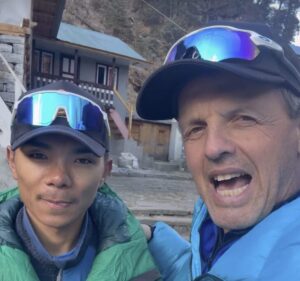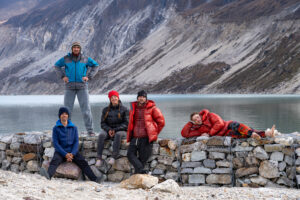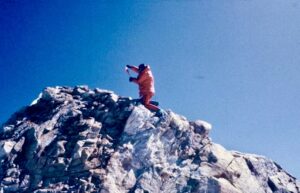Basque climber Alex Txikon and Nepalis Chhepal Sherpa, Tenjen Sherpa, Pasang Norbu, Gyalu Sherpa, Mingtemba Sherpa, and Pemba Tashi summited Manaslu on January 6. It took them two days from their Advanced Base Camp. The expedition set up their first, lower base camp on Dec. 26.
Theirs was undoubtedly a remarkable feat, done in tough conditions, at a very fast pace. It even featured a close call on the descent, when Pemba Tashi slipped and fell over 300m down the mountain.
Txikon used no supplementary O2, although the Sherpas did. In that sense, the style was similar to the first ascent of Winter K2 in 2021. Only on Manaslu, the team was smaller and the peak was 500m lower.

A ‘pure’ winter first?
Yet Txikon’s communication team noted that he had climbed Manaslu “for the first time in history in a purely winter expedition” and without the aid of artificial oxygen.

Txikon himself echoed this “first” claim in a press conference in Kathmandu on January 8, with Simone Moro at his side. Check part of it on a video shared on Instagram by team member Mingtemba Sherpa:
Txikon pointed out that his Nepali partners were the first in their country ever to summit a winter 8,000’er located in Nepal. “Nepalese summited K2 in 2021, but that’s Pakistan. And Ang Rita summited Everest [solo and without O2] but missed the ‘real’ winter by four hours.”
The 1984 Polish winter ascent
His statement has generated a lot of controversy, since most consider that the 1984 Polish expedition first climbed Manaslu in winter. Mazjec Maciej Berbeka and Ryszard Gajewski reached the 8,160m summit on January 12. Their all-Polish team climbed the Messner route on the south side of the mountain, in extreme conditions and with no supplementary O2 available.

Maciej Berbeka. Photo: Onet Podroze
So why should their expedition not be tagged as winter? Because the expedition set up their Base Camp on Dec. 2. By Dec. 21, the beginning of astronomical winter, they were already in Camp 3.
As for Nepali winter summits in Nepal, there have been a few, but all topped out before Dec. 21, except for Ang Rita. But there is an issue there, too.
Ang Rita’s winter Everest feat
Ang Rita Sherpa, climbing without supplemental O2, summited Everest with South Korean Young-Ho Heo at 2:20 pm on Dec. 22, 1987. After night fell, they had to bivouac in the open at 8,600m without proper gear. According to The Himalayan Database, the climbers “had to cradle each other to stay awake.”
“Heo used oxygen in C4 sleeping (2 liters/min) and climbing above C4 and at bivy,” the report reads. “Ang Rita used none at all. (Heo kept both sleeping masks and says Ang Rita did not use.)”

Ang Rita Sherpa atop Everest, Dec. 22, 1987
It requires a detailed inspection of astronomical charts to notice that that year, the winter solstice occurred in Nepal at 3:31pm. So Heo and Ang Rita stood on the summit not four minutes but 71 minutes before winter officially began.
It is unclear how long they were on the summit. But because of the late hour and the difficult descent ahead, they likely didn’t stay long enough to officially enter calendar winter.
Meteorological vs astronomical winter
The debate about what constitutes a winter climb spins around the two main definitions of winter. First, there is meteorological winter, from Dec. 1 to Feb. 28/29. Dec. 1 marks the official beginning of the winter season in Nepal, when winter permits become active, replacing fall permits. The second definition of winter is the one familiar to most of us, astronomical winter, running from Dec. 21/22 to Mar. 21/22.
Early Himalayan expeditions began as soon as possible after Dec. 1, the first day that their winter permit was active. By that date, teams were usually allowed to send staff ahead to set up their base camps. However, they were not supposed to start climbing before Dec. 21/22.

Denis Urubko on Winter K2. Photo: Denis Urubko
Winter expeditions in Nepal are supposed to finish by February 28. If they want to continue, they have to pay for a spring permit. Winter climbers such as Denis Urubko follow those criteria. For Urubko, the beginning of December is a fair date for starting a winter climb, while spring begins on March 1.
For those following astronomical winter — mainly Western teams — the key question was when they actually summited.
“If a summit is reached in winter, it is a winter climb,” mountaineering historian Damien Gildea told ExplorersWeb. Simone Moro disagrees. And apparently, Txikon does, too.
The purist version
Moro applies stricter criteria. He believes that pure winter expeditions should not even set foot in Base Camp before Dec. 21/22. They may, however, train at altitude on other mountains. This is what Moro and Txikon did before heading to Manaslu.
Take, for instance, the current team trying to open a route on Cho Oyu. If they returned from their current break in Kathmandu and succeeded, their climb might be considered winter or not, depending on which criteria are used.

Alex Txikon (left) and Simone Moro on Manaslu some days ago. photo: Simone Moro
Comparison to Winter K2
The lack of a single authority to decide what counts as a winter climb has been a headache for most teams. You can make your claim on Instagram, but that’s pr, not an authoritative source.
When planning for Winter K2, Mingma G decided that they would try to stick to the narrowest margins in order to avoid controversy. They would climb only from Dec. 21 and stop by Feb. 28.
Mingma G, Kili Sherpa, and Dawa Sherpa reached K2 Base Camp on December 18, 2020, but didn’t move up immediately.
“We took complete rest on the 19th and 20th of December,” Mingma G told Outdoorjournal. “The reason was our never-ending debate about which season to follow, the meteorological season from Dec. 1 to Feb. 28/29, or the astronomical season from Dec. 20 to March 20. We didn’t want [a] controversy, so we chose to start our climb on December 21.”
His plan paid off. They joined forces with other Nepalis in Base Camp and 10 of them summited on January 16, 2021.

Nepalis on the summit of K2, Jan. 16, 2021. Photo: Mingma G
All 8,000m peaks have now been summited in winter, one way or the other. Or have they? Depending on the criteria, some have not been, including Manaslu up till last week. That is why it was such an attractive goal for purist winter climbers.
Neither Moro nor Txikon announced that they intended to achieve a winter first on their previous Manaslu attempt. The claim has come after one of them summited.
In the end, as with so many other aspects of high-altitude mountaineering, there is no final word on the subject. However, chroniclers such as The Himalayan Database or 8000ers.com have their own rules. Climbers, especially those who have faced the 8,000’ers in winter, have their own differing beliefs. In an upcoming story, we will present a variety of different viewpoints.

The Manaslu winter team. Photo: Alex Txikon






